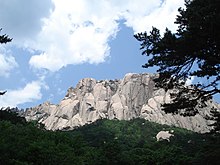Geography of Korea

Korea comprises the
At 223,179 km2, the area of Korea is similar to the area of the
The southern and western parts of the peninsula have well-developed plains, while the eastern and northern parts are mountainous. The highest mountain in Korea,
Unlike most ancient mountains on the mainland, many important islands in Korea were formed by volcanic activity in the Cenozoic orogeny. Jeju Island, situated off the southern coast, is a large volcanic island whose main mountain,
Because the mountainous region is mostly on the eastern part of the peninsula, the main
The southern and southwestern coastlines of Korea form a well-developed ria coastline, known as Dadohae-jin in Korean. This convoluted coastline results in mild seas, and this calm environment allows for safe navigation, fishing, and seaweed farming. In addition to the complex coastline, the western coast of the Korean Peninsula has an extremely high tidal amplitude (at Incheon, around the middle of the western coast, it can get as high as 9 m or 30 ft). Vast tidal flats have been developing on the south and west coastlines.
Physical geography

Mountains cover 70 percent of Korea and arable plains are generally small and fall between the successive mountain ranges. The peninsula becomes more mountainous towards the north and the east, with the highest mountains (including
The peninsula has 8,460 km (5,260 mi) of coastline, and the south and west coasts are particularly irregular. Most of the 3,579 islands off the peninsula are found along the south and the west coasts.
Climate

The climate of Korea differs dramatically from north to south. The southern regions experience a relatively warm and wet climate similar to that of Japan, affected by warm ocean waters including the East Korea Warm Current. The northern regions experience a colder and to some extent more inland climate, in common with Manchuria. For example, the annual precipitation of the Yalu River valley (600 mm or 24 in) is less than half of that on the south coast (1,500 mm or 59 in).[3] Likewise, there is a 20 °C (36 °F) difference in January temperature between the peninsula's southern and northern tips.
The entire peninsula, however, is affected by similar climatic patterns, including the
Biology
Surveys of Korean flora have identified more than 3,000 species on the peninsula, of which more than 500 are endemic. The peninsula's floristic provinces are commonly divided between warm-temperate, temperate, and cold-temperate zones. The warm-temperate zone prevails over the southern coast and islands, including Jeju-do. It is largely typified by broad-leaved evergreens.
The temperate zone covers the great majority of the peninsula, away from the southern coast and high mountains. It is dominated by the Korean pine and various broad-leaved deciduous trees. Cold-temperate vegetation is found along the peninsula's northern fringe and in the high mountains, including the upper reaches of Hallasan on Jeju. Evergreens in this area include larch and juniper. Much of this vegetation is shared with Manchuria.
According to the World Wide Fund for Nature, Korea consists of several ecoregions. The Southern Korea evergreen forests occupy the southernmost portion of the peninsula, as well as the island of Jeju. The Central Korean deciduous forests occupy the more temperate central portion of the peninsula. Manchurian mixed forests occupy the northern lowlands and low hills of the peninsula, and extend north into Manchuria as far as the Amur River on the Russia-China border. The Changbai Mountains mixed forests include the higher elevation mountain region along the North Korea-China border, where forests are dominated by conifers, with alpine meadows and rock slopes on the highest peaks.[4]
Geology

The terrain of Korea is rumpled, covered with low mountains. Most rocks are of Precambrian origin, although isolated pockets of Paleozoic, Mesozoic, and Cenozoic rock can also be found.
There are no active volcanoes on the peninsula. However,
See also
- Geography of North Korea
- Geography of South Korea
- Geology of North Korea
- Geology of South Korea
- Jeju Island
- Korea
References
- ^ Korean Map Archived 2013-07-23 at the Wayback Machine, The People's Korea, 1998.
- ISBN 978-89-6811-369-7.
- ^ KOIS 2003, p. 17.
- ^ "Changbai mountains mixed forests". Terrestrial Ecoregions. World Wildlife Fund. Retrieved 8 April 2011.


